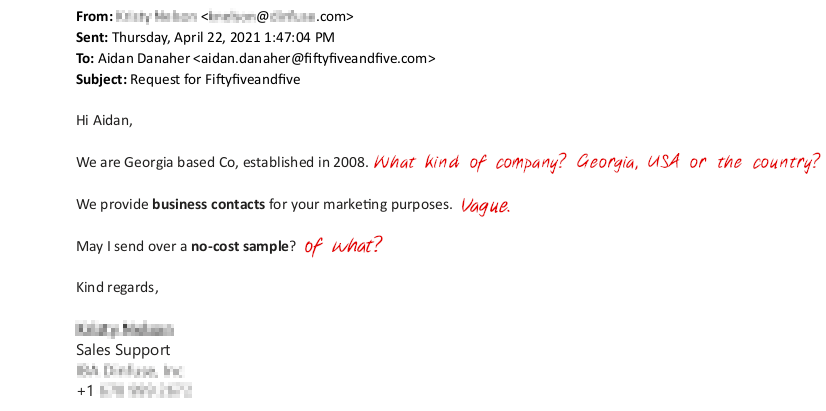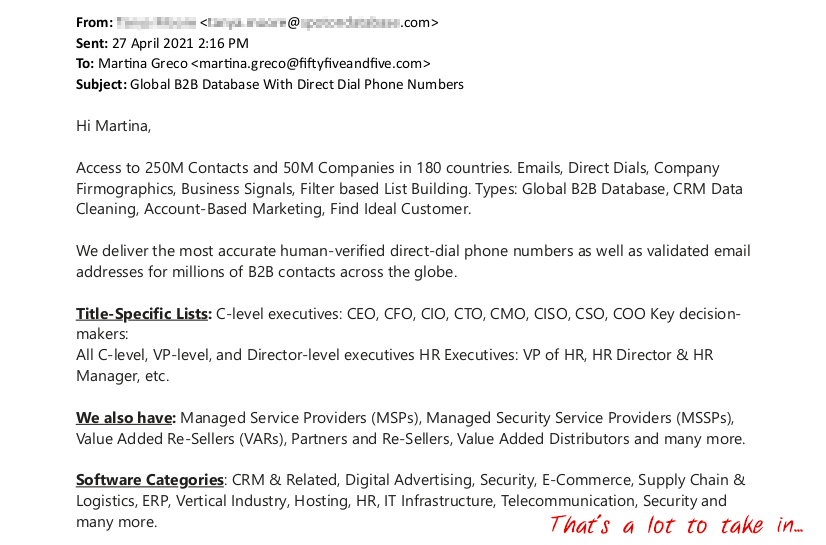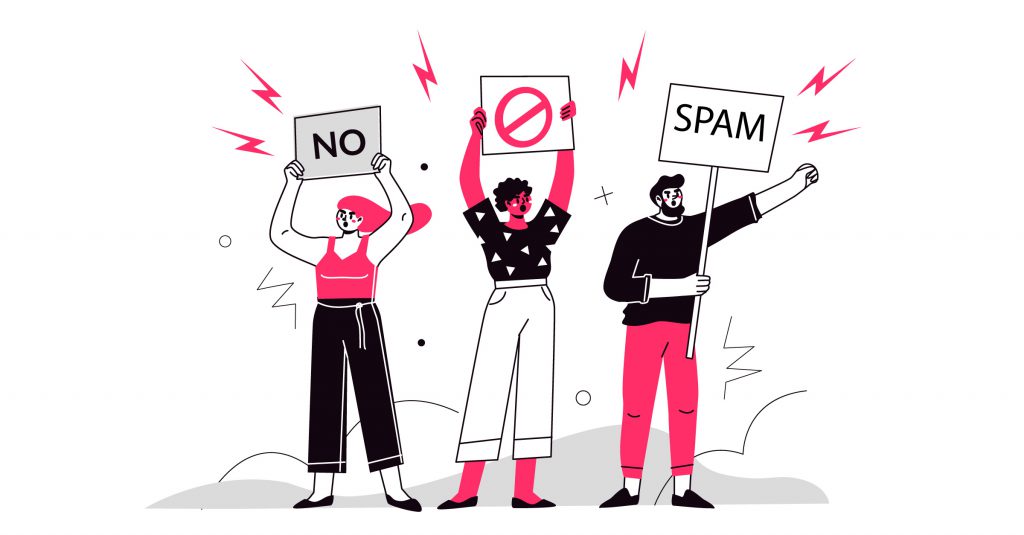Any business with an online presence has received their fair share of bad marketing emails. And we’re no exception. You would not believe some of the email marketing mistakes that have found their way into our inboxes. Sometimes we’re tempted to hit ‘reply’ and start typing “I think you may need a little help with your digital marketing…”
Well, in this blog, we’ll be doing just that. We’ll take some examples we’ve received, cast a critical eye over the email marketing mistakes that have been made and provide some constructive advice on how to fix them.
So, without further ado, and with their names and businesses disguised to protect the (not so) innocent – let’s take a look at some email fails:
1. Don’t just ‘phone it in’

It’s often said that being brief and getting straight to the point are big virtues in marketing – or in any kind of communications. Here, the spirit of Ernest Hemingway is alive and well. But this is taking that mantra a little too far. Not only aren’t they demonstrating any interest or insight into our business, but they’re also giving us no real information about theirs. Call me cynical, but this does not strike me as an email that was written with a great deal of effort and consideration.
What can we tell from this email?
- They’re a company of some kind (well, that narrows it down).
- They provide ‘business contacts’ for ‘marketing purposes’ – so far, so vague.
- They’d like to send over a ‘sample’ for free. A sample of what? One list? One contact?
Okay, you don’t want to drown your recipients in an ocean of unnecessary text. That’s often a good way to end up in the ‘Deleted items’ folder. But you have to be clear about who you are, your product or service and the value you offer prospective customers.
Moral of the story: put some thought and craft into it. Think about your value proposition and your audience’s needs and goals. If you express those, you’ll be off to a good start.
2. Target and personalise

We just warned against the dangers of being too brief. Well, this is the opposite. The sender clearly hasn’t segmented their list of contacts or their offerings in any way – they’re just telling us about every single thing they provide. Which, by the looks of things, includes everything but the proverbial kitchen sink.
The only thing here that’s in any way personalised or targeted is the recipient’s name – ‘Hi, Martina’. That’s it. There’s no attempt to engage the reader in terms of their individual role/organisation or initiate a ‘conversation’ with them – just straight in with ‘Access to 250M contacts…’ This email feels like a lot like spam – one of the biggest email marketing mistakes you can make – and is likely to be treated accordingly.
If you don’t want to end up in the spam folder, don’t act like a spammer. On the other hand, if you give the impression that it’s a credible inquiry, speaking to the recipient’s particular company’s needs, they’ll be much more likely to give you the time of day.
3. Always, always, always do your homework

At first glance, this looks good, right? Personalised, targeting a specific business decision-maker, appealing to a business goal – growth. Except Barnaby isn’t the founder – he’s the Head of Creative. Which they can find out pretty easily via that LinkedIn profile they linked in the very same sentence. Or our website.
This was a good attempt at targeting and personalisation. But when those personalised details are completely (or even a little bit) wrong, it has the exact opposite effect to what was intended. So, here’s the lesson from this one: always do your homework. Or if you’re using details from a list of leads, make sure those details are correct – and if you aren’t sure, don’t take a gamble.
Our tips for winning email marketing
So, as we’ve covered, it’s easy to write an email. But it can be a lot trickier to write a good marketing email. To conclude, let’s look at some of the key points from the examples here well as some email marketing tips and tricks from our team.
- Get your value across clearly. And show the recipient how it’s relevant to their specific role/organisation. Why is your offering a good thing for them? Why should they choose you instead of a competitor?
- Personalise as much as you can so they don’t just feel like one of many people on a very long list. This will also help you with the first tip – targeting your messages/offering to the specific person you’re talking to.
- Don’t be overly familiar if you don’t know the recipient. As our CEO Chris says, “You don’t get past my inbox just by pretending to know me.” Genuine and friendly is good. Trying to trick your audience definitely isn’t.
- Think twice before starting with “I know you’re busy…” – it’s such a cliché. OK, you value the recipient’s time – that’s good. Demonstrate that – you don’t necessarily have to say it. Or maybe not in those exact words, anyway.
- Proof-read everything before you click ‘send’. I’m sure you noticed a few typos in some of the examples we showed. Everyone makes mistakes, but they give the impression of a lack of diligence and professionalism. If you spot them first, your recipients won’t.
Well, that wraps it up. I hope you’ve found this article useful. And to all the senders featured in these email fails – no hard feelings. We just needed some real-life examples of email marketing mistakes for illustrative purposes. And if you’d like a little help with making sure you nail yours in future – drop us an email?
Want to start winning new customers and growing your existing business with better email marketing? Let’s talk. Get in touch with the team at Fifty Five and Five today.

